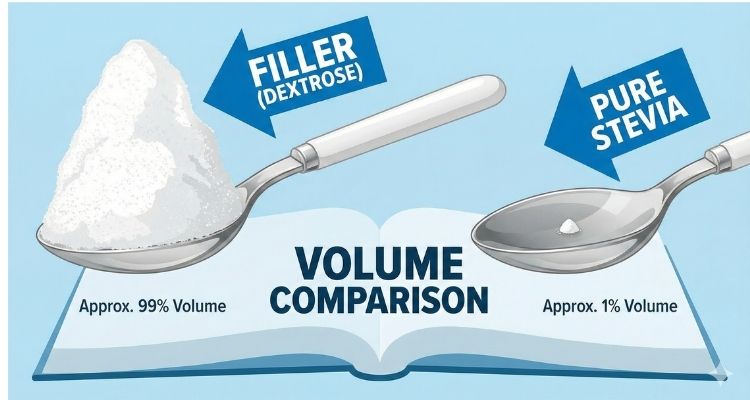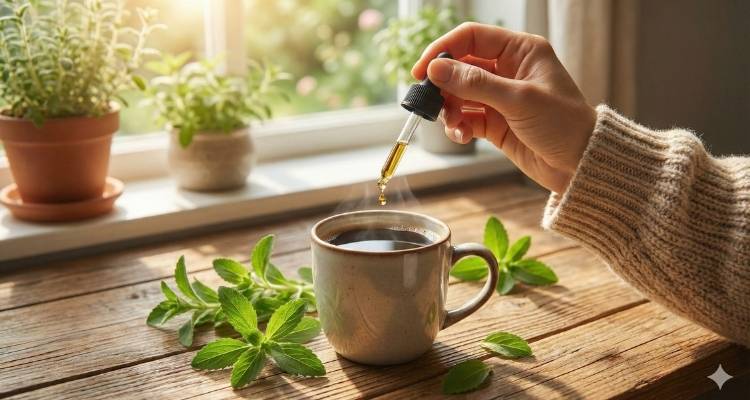Stevia Leaf Extract Guide: Decoding Labels to Avoid
Fillers and Find True Purity
Finding a genuine, high-quality stevia leaf extract shouldn't require a degree in chemistry, but lately, walking down the sweetener aisle feels more like navigating a minefield than shopping for food. You are doing the hard work—cutting sugar, managing your macros, perhaps navigating diabetes or chasing metabolic flexibility on keto.
You grab the green packet because the box promises a "natural" solution. So why are you still bloated? Why is the scale stuck? Why did your blood sugar spike after that "keto-friendly" coffee?
I get it. I really do. As a student in agricultural sciences, I spend my days analyzing how food is grown and processed. But as someone who grew up on a farm and tends an organic home garden, I also know that nature doesn't produce white, crystalline powders that dissolve instantly in cold water.
Here is the hard truth: most products sold as "stevia" are engineering compromises. To make a leaf that is 300 times sweeter than sugar measurable for your spoon, manufacturers dilute it with cheap fillers that can silently sabotage your health goals.
In this page, we are going to peel back the marketing label. I’m going to help you identify the metabolic saboteurs hiding in plain sight and guide you to the pure, clean options that actually deliver on the promise of natural sweetness.
Summary in Bullets: The "Too Long; Didn't Read"
Protection Plan
If you are standing in the grocery store right now and need a quick answer, here is the breakdown of why your current sweetener might be failing you:
- The 99% Filler Trap: Pure stevia is so potent that a single serving is smaller than a match head. To fill the packet, manufacturers add 99% fillers. If the first ingredient is Dextrose (sugar) or Maltodextrin (processed starch), you are essentially eating sugar.
- The Gut Bomb: Many "natural" blends use Erythritol or Inulin. While lower in calories, these can cause severe bloating ("The Sponge Effect") and gas, and emerging research raises questions about erythritol and heart health.
- Liquid is Safer: Liquid stevia drops suspended in water or alcohol rarely require bulking agents. They are almost always cleaner than powders.
- The Rule of Purity: If the ingredients list is longer than three items, put it back. True metabolic freedom comes from pure stevia leaf extract, water, and perhaps organic alcohol—nothing else.
The
"Natural" Trap: From Green Leaf to White Powder
Growing up, we chewed on stevia leaves right from the garden. They are incredibly sweet, but they also have a grassy, slightly bitter herbal note. That is the reality of the plant Stevia rebaudiana.
However, the modern consumer doesn't want a grassy leaf; they want a sugar-like experience. To achieve this, the industry uses extensive extraction and purification processes.
The Extraction Reality

While you might imagine a simple tea-steeping process, industrial extraction often involves chemical solvents such as ethanol or methanol to isolate specific stevia ingredients—the sweet glycosides like Rebaudioside A (Reb A).
- Organic Stevia: The "Organic" seal is your first line of defense here. It legally restricts the use of synthetic solvents like hexane during processing, mandating cleaner methods (often water or organic alcohol).
- The "Natural Flavor" Loophole: You will often see "Natural Flavors" listed on stevia drops. Generally, it is a "black box" term. It can legally hide proprietary processing aids or flavor modulators used to mask the metallic aftertaste of cheap extracts. While not always harmful, it represents a lack of transparency that we should view with caution. 🧐
The Metabolic Saboteurs: Why Your "Stevia" Might Spike Insulin

This is the most critical section for my diabetic and keto friends. The primary keyword on the front of the box says "Stevia," but the nutritional reality on the back is often entirely different.
Dextrose and Maltodextrin: The "Trojan Horse"
Ingredients
If you see Dextrose or Maltodextrin on the label, you are being misled.
- Dextrose is chemically identical to glucose (blood sugar). It has a Glycemic Index (GI) of 100.
- Maltodextrin is a highly processed starch derived from corn or wheat. It spikes blood sugar even faster than table sugar, with a GI ranging from 85 to 105.
Why are they there? Because they are cheap, white, and fluffy. They bulk up the microscopic amount of stevia so it pours like sugar. But for your body, that packet is no longer a "zero-calorie" metabolic free pass; it is an insulin trigger. 🛑
The Gut Disruptors: Erythritol and the "Sponge
Effect"
Many "better" brands like Truvia or Splenda Naturals swap the dextrose for Erythritol. While erythritol does not spike blood sugar, it introduces a different set of problems that I see constantly in the agricultural and nutritional literature.
The Osmotic "Sponge"
Erythritol is a sugar alcohol (polyol). Your body absorbs it but cannot metabolize it. As it travels through your digestive tract, it can act like a sponge, pulling water from your body into your colon via osmosis.
- Result: This rapid fluid influx causes distinct "rumbling," cramping, and osmotic diarrhea, especially if you exceed your personal tolerance threshold (which can be easily done with a few keto cookies).
The Cardiovascular Warning
I must share a serious update from the academic world. Recent studies, including major research published in 2023, have found an association between high levels of circulating erythritol and an increased risk of cardiovascular events (heart attack and stroke) due to increased blood clotting. While the science is still evolving, for those of us prioritizing longevity, sticking to organic stevia without erythritol is the prudent, risk-averse choice. 💔
Brands’ Purity Protocols
Let's apply this research to the grocery shelf. I have categorized common brands based on their ingredient purity and metabolic safety.
🟢 Stevia Purity Protocol: "Green Light" List 🌿
These products meet the highest standards: **No high-GI fillers**, no gut irritants, and maximum purity.
🛒 Find These Clean Stevias:
The Liquid Mandate: A Strategic Recommendation
From what I've seen on the farm, the simplest solution is often the correct one. The fundamental problem with powdered stevia is the physics of "bulking." You cannot have a powder that measures like sugar without adding something to it.
The Solution?
Embrace the Liquid. Liquid stevia leaf extract does not need to be bulked up. The water or alcohol acts as the carrier, allowing you to dispense a precise, potent dose (2-4 drops) without ingesting grams of useless starch or gut-irritating polyols.

My Personal "Farmer's Market" Advice:
1. Buy Liquid Drops: Keep a bottle of Trader Joe’s Organic Liquid Stevia or SweetLeaf in your kitchen and your bag.
2. Check for "Ose" and "Ol": If you must buy powder, scan the label. If you see words ending in "-ose" (Dextrose) or "-ol" (Erythritol), put it back.
3. Respect the Potency: Real, pure stevia is intense. It does not taste exactly like sugar—it has a botanical personality. Start with fewer drops than you think you need.
By decoding these labels, you move from being a passive consumer to an empowered protector of your metabolism. You aren't just buying a sweetener; you are buying the absence of insulin spikes and inflammation. That is a purchase worth making. 💪✨
Further Reading from Authority Sources
To verify the science behind these recommendations, I encourage you to explore these resources:
1. Read more on stevia leaf extract safety and Acceptable Daily Intake (ADI)
2. Read more on stevia ingredients and cardiovascular risks associated with Erythritol
3. Read more on organic stevia standards and "Natural Flavor" regulations
